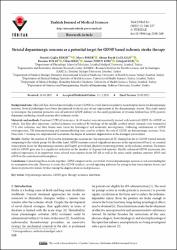Striatal dopaminergic neurons as a potential target for GDNF based ischemic stroke therapy

Göster/
Erişim
info:eu-repo/semantics/openAccessAttribution 4.0 Internationalhttps://creativecommons.org/licenses/by/4.0/Tarih
2022Yazar
Beker, Mustafa ÇağlarBeker, Merve
Çağlayan, Ahmet Burak
Bolat, Busenur
Kılıç, Ülkan
Köse, Gamze
Kılıç, Ertuğrul
Üst veri
Tüm öğe kaydını gösterKünye
Beker, M. Ç., Beker, M., Çağlayan, A. B., Bolat, B., Kılıç, Ü., Köse, G. ve Kılıç, E. (2022). Striatal dopaminergic neurons as a potential target for GDNF based ischemic stroke therapy. Turkish Journal of Medical Sciences, 52(1), 248-257. https://doi.org/10.3906/sag-2108-268Özet
Background/aim: Glial cell-line-derived neurotrophic factor (GDNF) is a well-known regulatory neurotrophic factor on dopaminergic neurons. Several pathologies have been documented so far in case of any impairment in the dopaminergic system. This study aimed to investigate the potential protective role of lentiviral GNDF delivery on the small population of tyrosine hydroxylase (TH) positive dopamine producing striatal neurons after ischemic stroke. Materials and methods: Fourteen C57BL/6J male mice (8–10 weeks) were intracerebrally treated with lentiviral GDNF (Lv-GDNF) or vehicle. Ten days after injections, cerebral ischemia was induced by blockage of the middle cerebral artery. Animals were terminated 72 h after ischemia, and their brains were taken for histological and molecular investigations. Following confirmation of GDNF overexpression, TH immunostaining and immunoblotting were used to evaluate the role of GDNF on dopaminergic neurons. Next, Fluro Jade C staining was implemented to examine the degree of neuronal degeneration at the damaged parenchyma. Results: Neither the amount of TH positive dopaminergic neurons nor the expression of TH changed in the Lv-GDNF treated animals comparing to the vehicle group. On the other hand, GDNF exposure caused a significant increase in the expression of Nurr1, an essential transcription factor for dopaminergic neurons and Gap43, growth and plasticity promoting protein, in the ischemic striatum. Treatment with Lv-GDNF gave rise to a significant reduction in the number of degenerated neurons. Finally, enhanced GDNF expression also induced expression of an important stress-related transcription factor NF-κB as well as the nitric oxide synthase enzymes iNOS and nNOS in the contralesional hemisphere. Conclusion: Considering these results together, GDNF’s impact on the survival of striatal dopaminergic neurons is not outstanding for its neuroprotective role. However, it seems that GDNF conducts several signaling pathways by acting on key transcription factors and shows its protective feature by fine-tuning the degeneration-related processes.
WoS Q Kategorisi
Q4Scopus Q Kategorisi
Q3Kaynak
Turkish Journal of Medical SciencesCilt
52Sayı
1Koleksiyonlar
- Makale Koleksiyonu [295]
- Makale Koleksiyonu [3649]
- Makale Koleksiyonu [176]
- PubMed İndeksli Yayınlar Koleksiyonu [4047]
- Scopus İndeksli Yayınlar Koleksiyonu [6283]
- TR-Dizin İndeksli Yayınlar Koleksiyonu [2175]
- WoS İndeksli Yayınlar Koleksiyonu [6432]


















